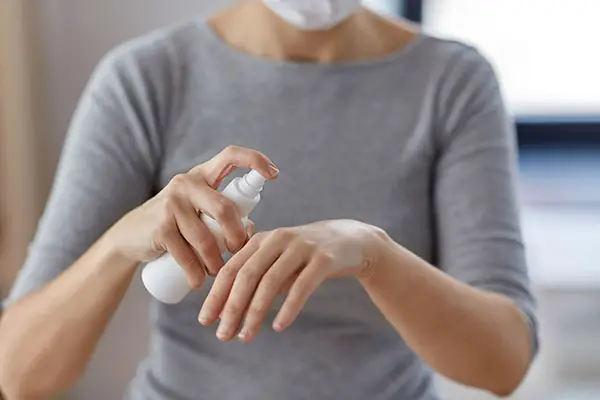Hand Sanitizer Proportions Calculator
You can use this hand sanitizer proportions calculator to determine the amount of alcohol you will need to include in a hand sanitizer according to the proportions of the other components.
You can use this calculator to compute what percentage of active components you will need to include in the mixture to meet the sanitization requirements outlined by the World Health Organization (WHO).
Reference
The World Health Organization (WHO) has published two formulations that can be used to prepare hand sanitizer. The details of these formulations are presented below.
Formulation I
Formulation I requires the hand sanitizer to meet the minimum final concentrations of hydrogen peroxide (H2O2) 0.125% v/v, glycerol 1.45% v/v, and ethanol 80% v/v.
Pour the following into a 1000 ml graduated flask:
- ethyl alcohol (ethanol) 96% v/v, 833.3 ml
- hydrogen peroxide 3%, 41.7 ml
- glycerol 98%, 14.5 ml
Use distilled water or water that has been boiled and cooled to top up the flask to 1000 ml. Shake the flask to combine the water with the ethanol, hydrogen peroxide, and glycerol.
Formulation II
Formulation II requires the hand sanitizer to meet the minimum final concentrations of hydrogen peroxide (H2O2) 0.125% v/v, glycerol 1.45% v/v, and isopropyl alcohol 75% v/v.
Pour the following into a 1000 ml graduated flask:
- isopropyl alcohol (with a purity of 99.8%), 751.5 ml
- hydrogen peroxide 3%, 41.7 ml
- glycerol 98%, 14.5 ml
Use distilled water or water that has been boiled and cooled to top up the flask to 1000 ml. Shake the flask to combine the water with the isopropyl alcohol, hydrogen peroxide, and glycerol.
*It is imperative that only pharmacopeial quality reagents are used in the formulations as opposed to technical grade products.
Step by Step Preparation (Mixing Instructions)
- Ensure you wear goggles or glasses to protect your eyes while mixing the active components.
- Pour the alcohol contents of your chosen formulation into a sealable bottle, then add the hydrogen peroxide (H2O2) and the glycerol using a measuring cylinder.
- Add distilled water or water that has been boiled and cooled to top up the capacity to 1000 ml.
- Immediately place the cap on the bottle to prevent any of the alcohol from evaporating.
- Mix the contents thoroughly by shaking or stirring the bottle.
- Distribute the mixture between 100 ml dispensing bottles that incorporate sprays before placing them in storage for 72 hours. This will provide the spores in the alcohol with sufficient time to present.
- Label the container clearly before use to ensure it is used safely.
The final product will have the consistency of a liquid, not a gel. Carry the bottle around with you in small 100 ml bottles that have a spray because the spray will make it easier for you to apply the sanitizer to your hands.

Calculations Explained
Total Volume = Alcohol Volume × Alcohol Percentage / Final Strength
For example, 237 ml (ethyl alcohol) × 0.96 (96%) / 0.8 (80% strength) = 284.4 ml
Hydrogen Peroxide Volume = Total Volume × 0.00125 / Hydrogen Peroxide Percentage
284.4 ml × 0.00125 (0.125% final recommended percentage) / 0.03 (3% hydrogen peroxide) = 11.85 ml
Glycerol Volume = Total Volume × 0.0145 / Glycerol Percentage
284.4 ml × 0.0145 (1.45% final recommended percentage) / 0.98 (98% glycerol) = 4.2 ml
Example
To make 100 ml of hand sanitizer:
- 75.2 ml 99.8% isopropyl alcohol
- 4.2 ml hydrogen peroxide 3%
- 1.5 ml glycerol 98%
- Water (19.1 ml) to make a total of 100 ml.
More References
Show Me the Science – When & How to Use Hand Sanitizer in Community Settings
